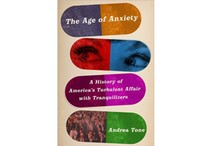The Age of Anxiety
By rea Tone
320 pages;
Basic Books
For two decades, the drug the Rolling Stones nicknamed "mother's little helper" was the most widely prescribed pill in the Western world—2.3 billion tablets in 1978 alone, enough to medicate half the globe. Andrea Tone's thoughtful, timely, and evenhanded narrative, The Age of Anxiety: A History of America's Turbulent Affair with Tranquilizers, locates the vertiginous rise, fall, and reascension of tranquilizers from Miltown to Xanax inside the complex sociohistorical context of the second half of the 20th century: "America was a land of suburban bomb shelters and 'duck and cover' drills, of houses and lawns overflowing with toddler spit-up and baby buggies, and of Wall Street denizens scrambling to keep up with the Joneses." Tone chronicles tranquilizers' impact on the most creative and influential figures of the time, from Salvador Dali's Crisalida, a multimedia homage to the first blockbuster tranquilizer, Miltown, to Barbara Gordon's memoir of Valium addiction, I'm Dancing as Fast as I Can, to Betty Ford's televised confessions, to Aldous Huxley's prediction that science would discover a drug "capable of transforming time into eternity, of making the soul say yes to the world instead of no." Most significantly, Tone asks the imperative questions: To what extent have pharmaceutical companies pathologized problems that are simply the normal vagaries of life? In the absence of well-placed ads, how many Americans would identify social anxiety as a disorder requiring pharmacology? Are Xanax and its predecessors serving only to keep us from changing situationally unhappy lives? As one physician said, "It takes 30 seconds to write a prescription for Valium but 30 minutes to explain why a patient shouldn't have it." Tone's study suggests that might be time well spent.
— Pam Houston


